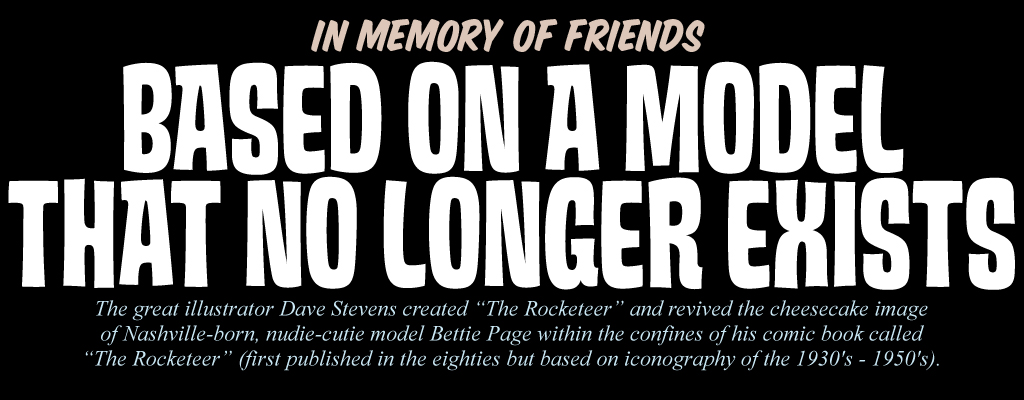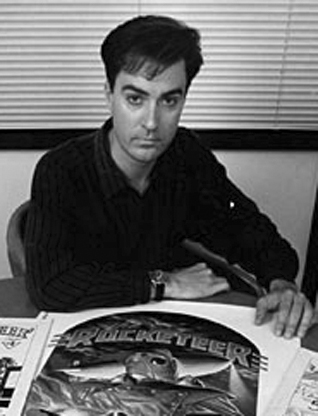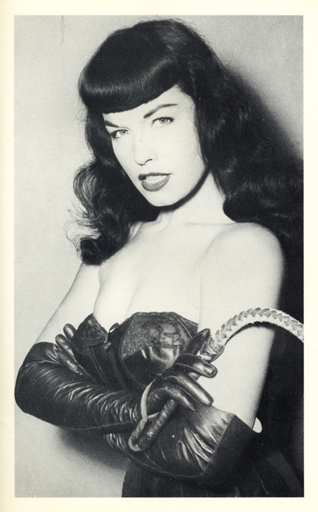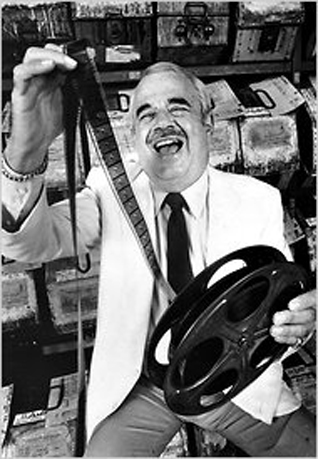
THE NEW McCARTHYISM (or BASED ON A MODEL THAT NO LONGER EXISTS)
For those of us who wanted to dig deeper, “The Rocketeer” comic book was a perfectly realized 'take' on pulp novels, cliff hanger cinema, and on the sexier side, a window to burlesque, post-war men's magazines, and the “McCarthy Era” of Elvis and E.C. Comics. Dave Stevens mashed three American decades into one world – and the heart of the story was a beautiful (Southern) starlet. In effect, this was a key example of what I hoped to do with my original pop culture creations. In reality, Bettie was outlawed in the same witch hunt era that doomed EC Comics and condemned “race” music. Stevens was exploring an entirely different example of classic pop culture censorship, exemplified in female. “36-24-36”.
Dave Stevens was only an acquaintance of mine, but in my formative years of looking for work at comic book conventions, he introduced me to Harvey Kurtzman, was supportive of my fledgling cartoon career, and regaled me with personal stories of his ongoing friendship with Bettie Page.

Dave Stevens
My cartooning style, retro all the way, was eventually noticed by Seattle based Fantagraphics Books. I was their only cartoonist to have continuing titles published on all three imprints; Fantagraphics, Monster, and Eros. I couldn't have been happier, as Fantagraphics Books published (or reprinted) all my favorite cartoonists.
Around 1990, Dave Stevens told me he was doing video jacket art for another Seattle company called Something Weird Video, fronted by cult film historian Mike Vraney. I'm sure their initial connection was the Bettie Page/Tempest Storm vehicle “Tease-O-Rama”.
Mike Vraney, in re-releasing old exploitation films, was giving forgotten cinema a new life. Especially the grindhouse fare of David F. Friedman, the king of “exploitation cinema”. Dave lived about 2 hours from my Memphis home, in Anniston, Alabama.

Mike Vraney
Something Weird Video had found it's identity in the “weird something” of “Exploitation”. The term sounded intriguing. It sounded like something dangerous, something lost, something worth defending. As it turned out, the brief histories of “Exploitation Film” and “Underground Comix” as progressive genres both had matching timelines within the sixties and seventies; a 'rise and fall' motif.
Whereas pre-code comic books and rock and roll radio music had become gentrified and safe, “Exploitation” films had ceased to exist all together, because they had either refused to change (like E.C. Comics), or were undermined (or tainted) by the 'end' model: pornography. Dave Friedman told me he had no interest in making porno. Too tawdry for an old Paramount man.
I'd heard that term “exploitation” before, in a life-changing book I'd bought in 1986, called “Re:Search; Incredibly Strange Films”. This tome of interviews and essays was compiled by V. Vale, Andrea Juno, Jim Morton, Boyd Rice). Unseen by me, these cult films seemed magical, and as 'punk' as anything else. From what I could gather, these unsung directors used their limitations (or flaws) as a style. You could call this “primitive”, “punk”, or “low budget”. To be 'real' and 'fake' in equal proportion, as if those words were emblazoned on the knuckles of each hand that pulled the trigger.

Bettie Page
The romance and metaphor of the 'lost film' began to develop inside me. I hungered to see these moving images, but “Re:Search; Incredibly Strange Films” timing was slightly ahead of the video curve that Something Weird Video would eventually 'exploit'. My imagination had taken root and by 1992, David F. Friedman and I met at a little bar at the Memphis airport, striking up a fast friendship. He signed a copy of his biography “A Youth in Babylon” and I gave him all my Fantagraphics comic books.
I was soon illustrating VHS covers for Something Weird Video, and eventually amassed a VHS collection of a hundred exploitation movies. I was receiving a film education on the cheap. An education, when combined with my sense of composition in comics, my tastes in rock & roll, and my ever-unfolding adoption saga, could only lead to my post grad-school drop out/post-acid years as “Guerrilla Monster Films”.
Simultaneously, the first-wave emergence of retro-minded women (free of eighties-style influence) arrived, much like lo-fi garage rock, early in the last decade of the twentieth century to save it from itself. David F. Friedman had made a film called “Starlet” in 1969 (the birth year of my starlet wife) and I picked up on the old Hollywood term. I wanted to re-define 'starlet' as someone who had no Hollywood pretensions, someone who was merely aware of her sexual power. I have promoted the term “starlet” as a visual equivalent to garage rock. I see both forms as last gasps (orgasms?) to the American Century as it came crashing to a cinematic close in 2,001 in the very city where comic books were created.
'Punk' is inclusive, but 'starlet' can only mean 'girl'. For my purposes, the starlet didn't have to act, she merely had to take off her clothes. In this physicality, exists a metaphor. She is revealing a mightier secret origin, and yet an unspeakable truth. This truth is sexual persona.
Author Camille Paglia had just written a book by the same title. It was a godsend and remains my favorite book of all time: “Sexual Personae; Art & Decadence from Nefertiti to Emily Dickinson” suggested to me the psychosexual missing links between comic books, rock & roll, and drive-in cinema. It validated my own dropping out of grad school and pursuing happier, more 'psychoiconoclastic' goals. Drawing a sexy girl was one thing, but revealing her sexual energy in three-dimensions was another.
The “Starlet”, like my cartooning style, was based on a model that no longer existed. Yet starlets appeared in Memphis quite frequently, sometimes covered in cartoon-tattoo's (tattoons?), to be in my films. Whereas Bettie Page had hailed from Nashville and David F. Friedman from Alabama, it was Memphis that gave the world Elvis. I was also from Tupelo, Mississippi. It seemed fitting to bring the curtain down on the American century right here in the South, where it all began.
Guerrilla Monster Films (initially called Big Broad Films) held our first exploitation movie premiere on January 8th, 1994 at Barristers Pub in downtown Memphis, the place where I had first laid eyes on future starlet D'Lana Tunnell. “Damselvis, Daughter of Helvis” would be my last complete comic book and my first low-budget movie.

Tempest Storm at Bettie's Funeral
Whenever possible, I would shoot (or premiere) my films on Elvis' “Birthweek” or “Deathweek”. The official term is “Elvis Tribute Week”, but I felt this was gentrified, a sanitized slogan for outsiders. My titles “Deathweek” and “Birthweek” tear down the slavish rock star notion, while suggesting the impersonal: a more cultish or primal aspect toward Elvis which includes his twin brother Jesse; their perfectly timed deaths (in regards to American pop culture), and the belief-system it would trigger in me later called The Gospelvis”.
Fast forward twenty years: 1994 to 2014...
Now that Guerrilla Monster Films is twenty years old, I intend to return to illustrating comic books. I will also continue to write screenplays. Making epics on a shoestring was fun, but ultimately frustrating. It made me realize that all the culture I have just mentioned is not only a model that no longer exists, but better worshipped elsewhere, like Europe and Japan. Some folks assume I will keep making psychotronic films as if I were a financially free, as if there was no psychic toll. Comics have no budgetary limitations, only eye-sight, time, and health. I always thought of my films as comic books.
I personally like the “The Rocketeer” movie, but what would it have been like if Dave Stevens made it himself? More flawed? More escapist? More fun?
I wanted to be the first cartoonist who put his own characters in his own hand-made feature films. In this, I have succeeded beyond my wildest dreams: I have the most beautiful women on earth as friends, I have a man who played a hippie in my movies as the godfather of my children, and a short list of collaborators (all around the world) who understood the comic book as low-budget film, and vice versa. I would take a bullet for them all; friends who were family because I didn't know who my blood family really was - and I still don't. Not completely.
So if Senator Joe McCarthy has become the symbol of censorship in the heart of the American century, let John Michael McCarthy bring redemption to the name at the end of the century. I assure you, no non-profits, corporations, or trust funds were used in the making of this art.
(1) Don't ask Permission (2) Shoot until they make you stop (3) Deny Everything.
This is the new McCarthyism.
JMM
January 1, 2014
Postscript:
Dave Stevens life was cut short by leukemia on March 11th, 2008 at the age of 52. Bettie Page passed away on December 11th, 2008 at the age of 85. So strange to me that Bettie Page should outlive Dave Stevens, and that they pass in the same year.
Dave Stevens told me he once took Bettie to a Los Angeles hospital when she felt ill, but in hearing her name announced over the PA, Dave thought the mere mention of “Bettie Page” would create a panic of interest. Of course, no one knew or cared who she was, only to her well-being. Impersonal. Dave Stevens laughed at his presumptions when he told me this story, but I shared them as well. American pop culture use to create a panic, indeed it changed the world. Bettie was the model who helped create the model.
Bettie Page was probably in no shape to visit Dave Stevens when he fell ill, but it stands in my imagination as a great scene in a movie that will never be made. In the short time she had left, I'm sure Bettie Page missed the hell out of Dave Stevens.

David F. Friedman
copyright 2015 by Mike McCarthy